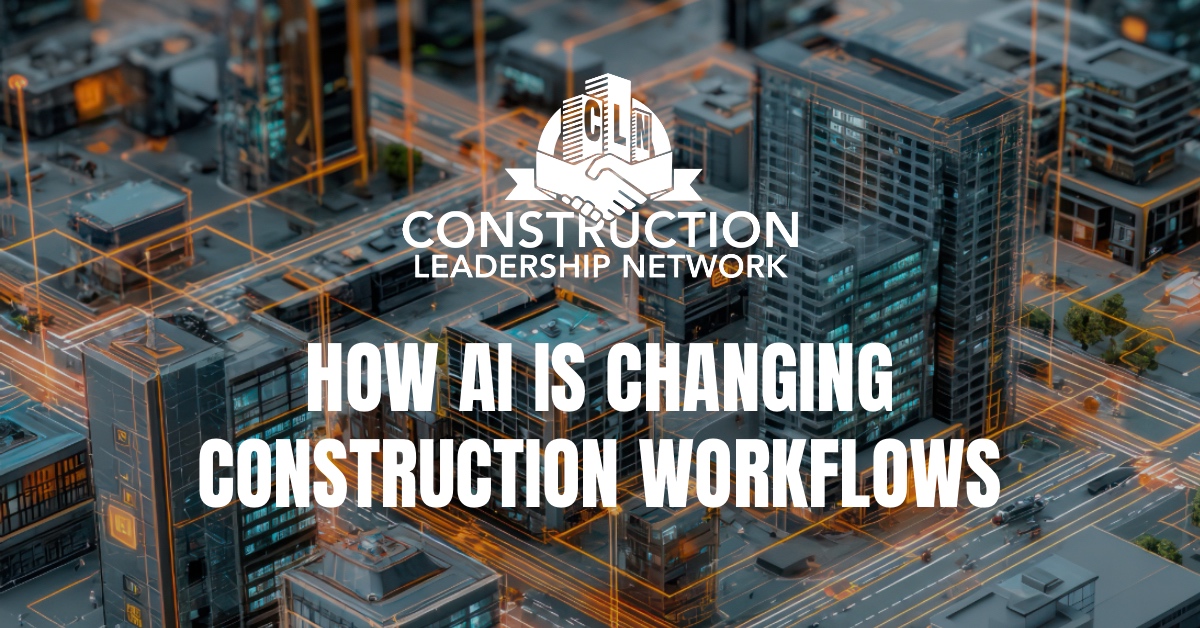
The construction industry is experiencing a digital shift, with adoption of AI in construction projected to reach $4.96 billion by the end of this year.
For small and mid-sized construction companies, this represents both an opportunity and a challenge: embrace these tools to stay competitive, or risk falling behind competitors who are already implementing them.
Companies implementing AI report average productivity gains of 20-30% and project timeline reductions of 15-20%. More importantly, they’re solving real operational problems that have plagued the industry for years.
How AI tackles everyday construction challenges
Project Management and Operations
AI-powered project management systems are helping contractors automate site reports, monitor safety compliance, and manage digital drawings more efficiently.
Instead of spending hours manually updating project status, these systems can analyze photos from job sites, compare progress against schedules, and flag potential issues before they become problems.
One of the most practical applications involves using AI assistants for routine administrative tasks. Some construction companies are beginning to experiment with general AI tools for relatively little cost per month, exploring applications like generating initial construction schedules from project descriptions, drafting safety protocols, and analyzing project specifications. What used to take project managers hours can now be completed in minutes.
Progress tracking represents another significant breakthrough. AI systems using computer vision can automatically compare actual site progress against project plans and schedules. Industry studies show that AI-driven planning and forecasting can reduce project delays by up to 30%, with some reports suggesting timeline reductions of up to 40%, by identifying problems early and enabling proactive schedule adjustments.
Tools to explore:
- SmartBuild – Cloud-based project management solutions, designed specifically for contractors, subcontractors and A/E Firms, offering automated design and construction management and reporting. Their new SMRT-E project coordinator app is a game changer for reporting on projects.
- Projexion.io – AI-powered management solution that pulls data from multiple platforms, including, ERP, project management, scheduling, estimating, etc. to create dashboards and provide you with KPI tracking and transparency of your data across your entire operations. No more information silo’s thanks to Projexion.
- Lumber – Lumber Construction Workforce Management streamlines Payroll, Time Tracking, Job Costing, and Project Management for Building Contractors.
Sales and Lead Generation
This is where AI delivers immediate value for business owners. According to Salesforce, 81% of sales teams are either experimenting with or have fully implemented AI tools, and construction companies are starting to see significant benefits from these technologies.
AI can analyze market data to identify potential projects before they’re widely advertised, giving contractors a head start on the competition. These systems scan building permits, planning applications, and development announcements to create qualified lead lists based on your construction company’s specific capabilities and geographic focus.
For market research and competitive intelligence, AI tools continuously monitor competitor activities, track pricing trends, and identify emerging opportunities. Instead of manually researching potential clients and projects, AI can deliver daily briefings on relevant business development opportunities, allowing sales teams to focus on relationship building and closing deals.
Tools to explore:
- Building Radar – Identifies high-margin construction projects early in the development cycle using AI market analysis
- Seamless.AI – Lead generation platform that provides verified contact information and business intelligence for construction prospects
- Crayon – Competitive intelligence platform that tracks competitor activities and market opportunities
Design Accuracy and Estimating
The impact of AI on estimating accuracy has been transformative. Traditional takeoff processes—where estimators manually measure and calculate quantities from plans—consume enormous amounts of time and are prone to human error. AI-powered estimating tools can analyze construction drawings and automatically calculate square footage, material quantities, and project specifications in minutes rather than hours.
A recent case study from a large Florida contractor demonstrates the potential impact. The company’s eight estimators were spending about 50% of their time on manual takeoffs. After implementing AI-powered estimating tools, they reduced this time to just 10% while improving accuracy from 97% to 98%. The time savings (14.5 hours per plan set) translated to 13,920 hours annually, representing approximately $1 million in first-year savings.
The efficiency gains extend beyond simple time savings. AI can analyze multiple project scenarios simultaneously, helping contractors optimize construction schedules and resource allocation. One European contractor used AI to analyze 300+ different construction scenarios in four days—a process that would have taken months manually, resulting in an 18% reduction in project duration and 15% in cost savings.
Tools to explore:
- Togal.AI – Automated takeoff and estimating platform that uses machine learning to analyze construction drawings
- ALICE Technologies – AI-powered construction scheduling and optimization platform for complex project scenario analysis
- Bluebeam – a comprehensive PDF solution tailored for architecture, engineering, and construction professionals.
Real challenges in AI adoption
Only 4% of construction companies currently use AI, compared to 12% in manufacturing. The barriers aren’t primarily technical; they’re practical and human.
Cost and ROI considerations:
While some AI implementations can require significant upfront investment ($15,000 to $150,000 for comprehensive systems), a recent IDC study commissioned by Microsoft reports that organizations are realizing an average return of 3.5x on their AI investments, with top performers achieving up to 10x ROI. The key is starting with focused applications that address specific pain points rather than attempting comprehensive digital transformation all at once.
Skills and training gaps:
While AI adoption is rising across industries, construction lags behind peers like manufacturing. McKinsey’s 2024 AI adoption survey found that 42% of organizations cite a lack of talent with appropriate AI skill sets as a critical barrier, second only to unclear strategy (43%). In construction, this skills gap intersects with an aging workforce and industry-specific resistance to digital disruption.
Integration complexity:
Construction projects are inherently unique, job sites often lack reliable internet connectivity, and integrating new systems with existing processes presents genuine challenges. Unlike manufacturing environments, where processes can be standardized, construction requires flexible solutions that can adapt to varying project requirements and site conditions.
Successful companies overcome these barriers through phased implementation. They start with one specific problem—perhaps automated takeoffs, lead generation, or safety monitoring—demonstrate value, then expand to other applications based on results and team confidence.
Future developments and preparation strategies
The trajectory is clear: AI in construction is projected to reach $22.68 billion by 2032.
Current developments include computer vision systems that identify safety violations in real-time (reducing accidents by 20%), voice-activated interfaces for hands-free data access in the field, and digital twin technology for predictive maintenance and lifecycle management.
Predictive maintenance powered by AI shows particular promise, with early adopters reporting 25% reduction in maintenance costs and 70% fewer equipment breakdowns. For companies with significant equipment investments, this could represent substantial savings and improved project reliability.
Government support is expanding as well, with many states offering grants and tax incentives for technology modernization, making adoption more financially accessible for smaller companies.
Building a strategic approach with AI in Construction
For small and mid-sized companies, preparation begins with data organization and standardization. Implementing cloud-based storage systems, standardizing data collection processes, and choosing technologies that can integrate with future AI tools creates a foundation for eventual AI adoption.
The most successful implementations start small and scale systematically. Identify one specific operational challenge—whether it’s estimating accuracy, lead generation, or project tracking—and focus on solving that problem well before expanding to other applications. This approach minimizes risk while building internal expertise and demonstrating value to skeptical team members.
The construction industry’s digital transformation is accelerating, driven by labor shortages, margin pressures, and increasing project complexity. Companies that begin exploring AI applications today position themselves not just for survival, but for competitive advantage in an increasingly technology-driven market.
The question isn’t whether AI will revolutionize the construction industry. It already is. The question is whether you’ll be leading that transformation or adapting to changes driven by others.
Ready to explore how AI can transform your construction business?
Join CLN’s virtual peer groups to connect with other construction leaders who are successfully implementing AI and digital technologies. Share experiences, learn from real-world case studies, and get practical advice from contractors who understand your challenges.
Learn more about CLN’s virtual peer groups and upcoming sessions.
